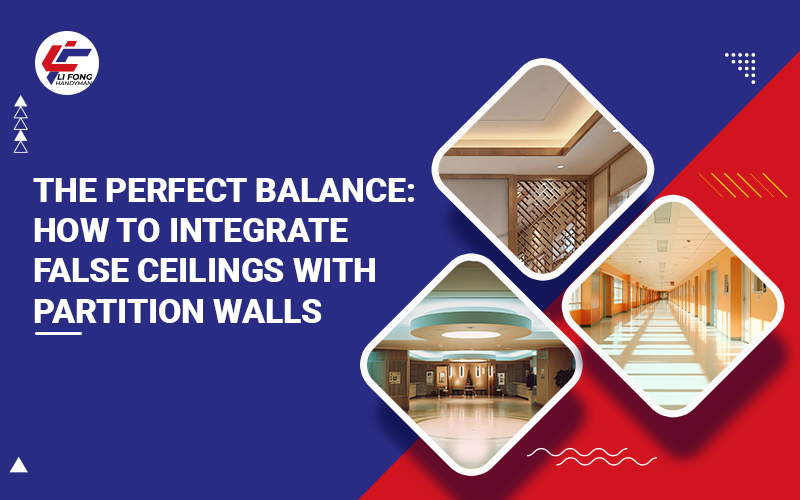Have you ever felt that your room is too big and messy? Like, there’s no privacy, no quiet corner to work or relax? You’re not alone. Many people, especially in Singapore, face the same problem with open-concept spaces.
One simple way to fix this is by using false ceilings with partition walls. This trendy new combo helps break big spaces without making them feel small or closed off. False ceilings can improve lighting, cut down noise, and make the room feel more comfortable. Partitions add just enough privacy and structure to feel more relaxed.
In this article, we’ll share some tips for simple yet elegant design, materials to choose from, and how to install them properly.
Benefits of Integrating False Ceilings with Partition Walls
Here’s why you should combine your false ceilings and partition walls:
1. Enhanced Spatial Definition: You can divide a large room into smaller areas without making it feel cramped. This setup helps each area serve its purpose, like a work corner, a meeting room, or a quiet reading space, while still feeling connected to the rest of the room.
2. Improved Acoustics: Soundproof partition walls with a ceiling help block out sound between areas. It’s great for both homes and offices.
3. Aesthetic Appeal: You don’t need any fancy decorations to make a space look good. A well-designed ceiling paired with partitions brings depth and style.
Design Strategies for Combining False Ceilings and Partition Walls
Here’s how you can bring your false ceilings and partition walls together in a way that just clicks
Coordinated Materials and Finishes
- Harmonious Design: Choose materials that match or complement each other. When your ceiling and partition blend well, the whole space looks smooth and balanced.
- Texture Play: Don’t be afraid to mix textures! Adding variety, like soft fabrics next to sleek panels, can make your space feel alive and interesting.
Strategic Lighting Integration
- Zonal Lighting: Set up lights that focus on different areas like over your desk, dining area, or reading corner. With zonal lighting, you can focus better and create a warm, welcoming vibe.
- Ambient and Task Lighting: You can blend soft overall lighting with stronger, focused lights. This way, you’ve got the perfect light whether you’re relaxing or working.
Partial and Transparent Partitions
- Open Feel: Use half walls or glass partitions to divide space. They give you privacy without blocking the light or the view.
- Decorative Elements: You can add shelves, artwork, or custom designs into your partitions. Not only do they divide the space, but they also make your room look stylish and functional at the same time.
Practical Applications in Different Settings
Residential Spaces
- Living and Dining Areas: You can easily define your living and dining spaces by adding ceiling drops or soft partitions. It helps each space feel more defined and less messy.
- Home Offices: You can instantly create a private, focused workspace right inside a larger room. All you need a smart ceiling design paired with a light partition.
Commercial Spaces
- Open-Plan Offices: You can carve out clear workstations and meeting spots by an office false ceiling with partitions. It keeps everything open but gives everyone their own workspace.
- Retail Environments: Use different ceiling and partitions to naturally guide customers through your store. This helps to highlight your best products and makes shopping feel easy and inviting.
Case Studies and Examples

Are you looking for ideas from actual work? Here are some real-life examples that show how combining false ceilings and partitions can completely change a space.
Innovative Residential Designs
- Case Study 1: In a modern apartment, a couple divided their space using a recessed ceiling and wooden slats. They created a quiet, cozy reading room and dining room without closing off anything.
- Case Study 2: A family used ceiling beams and low walls to divide the kitchen from the living room. Now, they can cook, talk, and relax all in one space.
Creative Commercial Implementations
- Case Study 3: An office used glass partitions and dropped ceilings to create meeting rooms in their open-plan office. They designed a space where everyone got a bit more focus and privacy while still keeping light and openness.
- Case Study 4: A small boutique turns heads with decorative ceiling shapes and built-in shelving walls. It not only looks great but also leads shoppers right to key products.
Considerations for Implementation
Before you make any decision, here are few things you need to consider:
Structural and Safety Aspects
- Load-Bearing Evaluation: Always check if your ceiling or walls can support the new features. It’s better to be safe than face damage later on.
- Fire Safety Compliance: Always use approved, fire-rated materials and follow building codes. This keeps your home or office safe.
Maintenance and Durability
- Material Selection: Go for materials that are strong and easy to clean. This saves time and keeps everything looking good for years.
- Future Flexibility: Design with change in mind. Use modular or movable options so you can adjust your space later without major hassle or cost.
Understanding False Ceilings and Partition Walls
Before you start choosing styles and layouts, let’s take a step back and take a peek at false ceilings and partition walls.
What Are False Ceilings?
- False ceilings are secondary layers below the main ceiling. You can choose from options like gypsum, wood, or metal, each of which gives a different feel and look.
- With a false ceiling, you can hide wires, add mood lighting, and even control heat better. Plus, it brings a clean, finished look to any room.
What Are Partition Walls?
- Partitions come in many forms: Glass for openness, wood for warmth, gypsum for ease, or movable ones if you need flexibility.
- Partitions let you split up a space without closing it off. You can keep things open but still create quiet zones where they’re needed.
The Perfect Balance: How to Integrate False Ceilings with Partition Walls

When false ceilings and partition walls work together, your space feels intentional and balanced. Here’s how to make the two elements connect smoothly and stylishly.
Creating Seamless Transitions
- You can extend parts of the ceiling over areas like dining or work areas. It gently marks the space without needing full walls.
- You can also use the same tones, textures, or finishes in both ceilings and partitions. ceilings and partitions.
Smart Lighting Techniques
- By installing recessed lighting that shines down on your partitions, you can create a design that adds depth without standing out too boldly.
- Hang stylish pendant lights or tuck LED strips into ceilings and walls. This adds personality and highlights your best design features.
Choosing the Right Materials
- If you want sound insulation, go with gypsum or acoustic panels. They also last long and are easy to maintain.
- You can go with eco-friendly options such as recycled wood or certified green boards to create a sustainable, stylish space.
Design Inspirations for Various Spaces
Whether it’s your home, office, or a public space, the right design can completely change how a place feels and works. Here are few ways you can instantly redesign your space,
Residential Applications
- You should use partial walls and recessed ceilings to carve out a peaceful corner for reading or working. It creates a sense of separation while keeping the space open and connected.
- You can create subtle divisions with low walls or hanging ceilings to keep the living and dining areas open yet distinct.
Commercial Applications
- You can set up different workstations using low partitions and stylish ceiling extensions. It creates a structured space while keeping the office feeling open and collaborative.
- You can also use elegant glass or wooden partitions to define product displays or changing areas. This adds privacy without interrupting the store’s open flow.
Hospitality and Public Spaces
- You should design your hotel lobby with beautiful false ceilings and well-placed partitions. It creates an inviting and stylish entryway.
- You can use lowered ceilings with soft lighting over tables to create a warm, intimate atmosphere. Pair them with partitions to give privacy without closing off the space.
Conclusion
Open spaces can feel a bit too loud, too exposed, or just not quite right for everyday living or working. That’s why more people are turning to false ceilings with partition walls. It’s a simple way to bring comfort, structure, and style into any room.
They help you break up large areas, giving you cozy corners to relax, work, or focus. Think about what you need most from your space. Mix and match materials, lighting, and layouts to build something unique that fits you perfectly. It’s all about making the space feel like it truly fits into your life.

